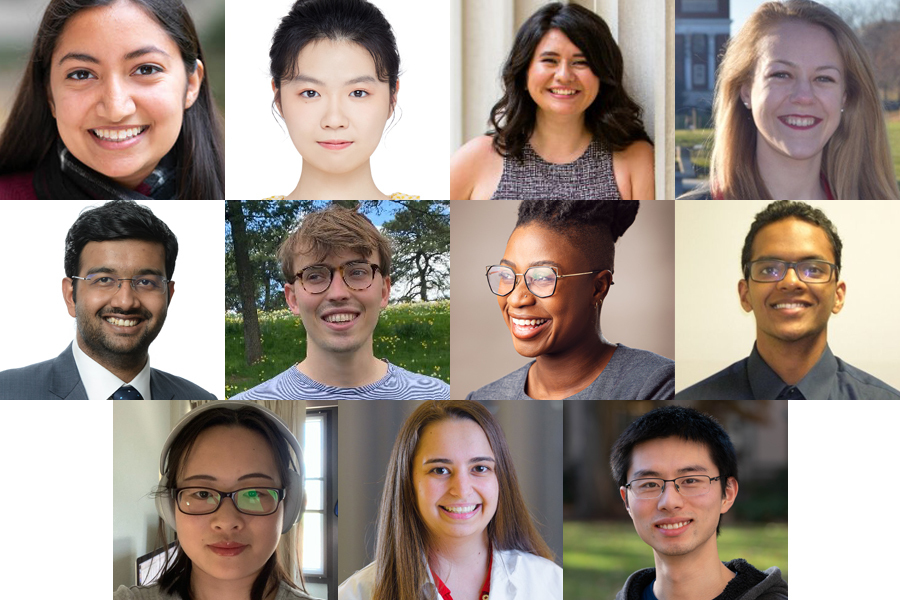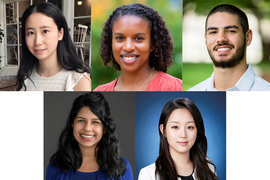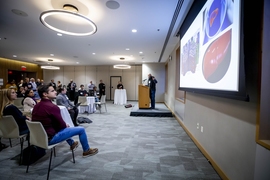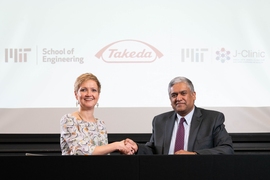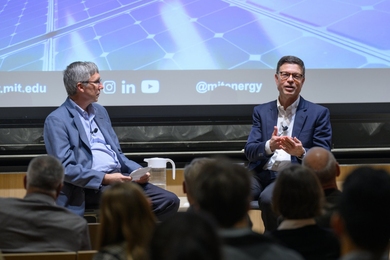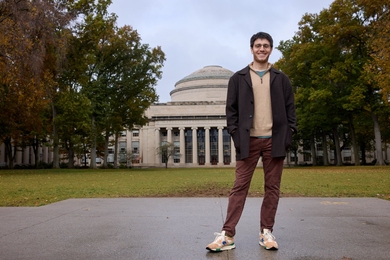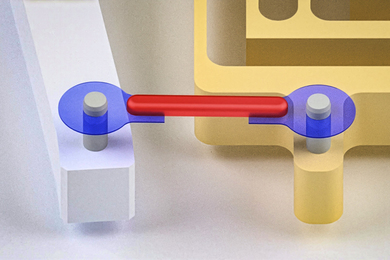In fall 2020, MIT’s School of Engineering and Takeda Pharmaceuticals Company Limited launched the MIT-Takeda Program, a collaboration to support members of the MIT community working at the intersection of artificial intelligence and human health. Housed at the Abdul Latif Jameel Clinic for Machine Learning in Health, the collaboration aims to use artificial intelligence to both benefit human health and aid in drug development. Combining technology with cutting-edge health research, the program’s participants hope to improve health outcomes across the world.
Thus far, the partnership has supported joint research efforts focused on topics such as automated inspection in sterile pharmaceutical manufacturing and machine learning for liver phenotyping.
Every year, the program also funds graduate fellowships to support students pursuing research on a broad range of issues tied to health and AI. This year’s Takeda fellows, described below, are working on research involving electronic health record algorithms, remote sensing data as it relates to environmental health risk, and neural networks for the development of antibiotics.
Monica Agrawal
Agrawal is a PhD student in the Department of Electrical Engineering and Computer Science (EECS). Her research focuses on the development of machine learning algorithms that could unlock the potential of electronic health records to power personalized, real-world studies of comparative effectiveness. She is tackling the issue from three interconnected angles: understanding the basic building blocks of clinical text, enabling the structuring of clinical timelines with only minimal labeled data, and redesigning clinical documentation to incentivize high-quality structured data at the time of creation. Agrawal earned both a BS and an MS in computer science from Stanford University.
Peng Cao
A PhD student in EECS, Peng Cao's research is focused on developing a new approach to monitoring oxygen saturation by analyzing the radio frequency signals that bounce off a person’s body. To this end, she is extracting respiration signals from the radio signals and then training a neural network to infer oxygen levels from it. Peng earned a BS in computer science from Peking University in China.
Bianca Lepe
A PhD student in biological engineering, Bianca Lepe is working to benchmark existing and defining next-generation vaccine candidates for tuberculosis. She is using publicly available data combined with machine learning algorithms to identify the Mtb proteins that are well-suited as subunit vaccine antigens across the diversity of the human leukocyte antigen alleles. Lepe earned a BS in biological engineering and business from Caltech; an MS in systems and synthetic biology from the University of Edinburgh in Scotland; and an MPhil in technology policy from the University of Cambridge in England.
Caroline McCue
Caroline McCue is a PhD student in mechanical engineering who is developing a system that could simplify and speed up the process of cell passaging. More specifically, she is designing and testing a platform that triggers cell detachment in response to simple external stimuli, such as a change in voltage or in mechanical properties. She plans to test the efficacy of this platform by applying machine learning to quantify the adhesion of Chinese hamster ovary cells to these surfaces. McCue earned a BS in mechanical engineering from the University of Maryland.
Somesh Mohapatra
A PhD student in the Department of Materials Science and Engineering, Somesh Mohapatra is also pursuing an MBA at the MIT Sloan School of Management as part of the Leaders for Global Operations Program. His doctoral research, in close collaboration with experimentalists at MIT, focuses on designing biomacromolecules using interpretable machine learning and simulations. Specifically, Mohapatra leverages macromolecule graph representations to develop machine learning models for quantitative prediction, optimization, and attribution methods. He then applies these tools to elucidate design principles and to improve performance and synthetic accessibility of functionality macromolecules, ranging from peptides and glycans to electrolytes and thermosets. Mohapatra earned his BTech in metallurgical and materials engineering from the Indian Institute of Technology Roorkee in India.
Luke Murray
Luke Murray is a PhD student in EECS. He is developing MedKnowts, a system that combines machine learning and human computer interaction techniques to reduce the effort required to synthesize knowledge for medical decision-making, and author high-quality, structured, clinical documentation. MedKnowts unifies these two currently splintered workflows by providing a seamless interface that re-imagines documentation as a natural byproduct of clinical reasoning, rather than as a compliance requirement. Murray earned his BS in computer science from Brown University.
Ufuoma Ovienmhada
Ufuoma Ovienmhada SM '20 is a PhD student in aeronautics and astronautics. Her research employs a mixed-methods approach (community-centered design, systems engineering, and machine learning) to satellite remote sensing data to create tools that evaluate how human health risk relates to environmental hazards. Ovienmhada earned her BS in mechanical engineering from Stanford University and her SM in media arts and sciences from MIT.
Lagnajit Pattanaik
Lagnajit “Lucky” Pattanaik is a PhD student in chemical engineering. He seeks to shift the paradigm of predictive organic chemistry from qualitative to quantitative. More specifically, his research is focused on the development of machine learning techniques for predicting 3D structures of molecules and reactions, including transition state geometries and the geometrical conformations that molecules take in solution. He earned a BS in chemical engineering from Ohio State University.
Na Sun
A PhD student in EECS, Na Sun is working in the emerging field of neuro-immuno-genomics. More specifically, she is developing machine learning methods to better understand the interactions between two extremely complex systems: the human brain and its dozens of cell types, and the human immune system and the dozens of biological processes that it integrates across cognition, pathogen response, diet-exercise-obesity, and synaptic pruning. Sun earned her BS in life sciences from Linyi University in China and an MS in developmental biology from the University of Chinese Academy of Sciences in China.
Jacqueline Valeri
Jacqueline Valeri is a PhD student in biological engineering who utilizes neural networks for antibiotics discovery. Her efforts include the recycling of compounds from existing compound libraries and the computationally assisted design of novel therapeutics. She is also excited by broader applications of machine learning and artificial intelligence in the fields of health care and biomedicine. Valeri earned her BSE and MSE in bioengineering from the University of Pennsylvania.
Clinton Wang
A PhD student in EECS, Clinton Wang SM '20 has developed a new type of conditional generative adversarial network based on spatial-intensity transforms. It achieves high image fidelity, is robust to artifacts in training data, and generalizes to held-out clinical sites. Wang now aims to extend his model to even more challenging applications, including visualizing transformations of focal pathologies, such as lesions, where it could serve as a powerful tool for characterizing biomarkers of malignancy and treatment response. Wang earned a BS in biomedical engineering from Yale University and an SM in electrical engineering and computer science from MIT.
